wiper blades GMC SIERRA 2007 Owner's Manual
[x] Cancel search | Manufacturer: GMC, Model Year: 2007, Model line: SIERRA, Model: GMC SIERRA 2007Pages: 680, PDF Size: 3.42 MB
Page 215 of 680
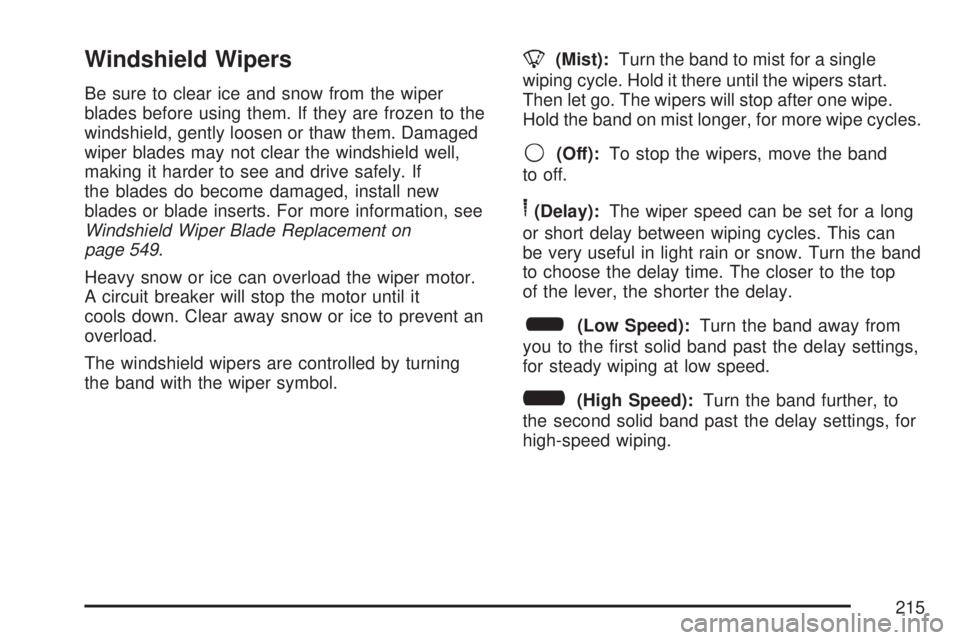
Windshield Wipers
Be sure to clear ice and snow from the wiper
blades before using them. If they are frozen to the
windshield, gently loosen or thaw them. Damaged
wiper blades may not clear the windshield well,
making it harder to see and drive safely. If
the blades do become damaged, install new
blades or blade inserts. For more information, see
Windshield Wiper Blade Replacement on
page 549.
Heavy snow or ice can overload the wiper motor.
A circuit breaker will stop the motor until it
cools down. Clear away snow or ice to prevent an
overload.
The windshield wipers are controlled by turning
the band with the wiper symbol.
8(Mist):Turn the band to mist for a single
wiping cycle. Hold it there until the wipers start.
Then let go. The wipers will stop after one wipe.
Hold the band on mist longer, for more wipe cycles.
9(Off):To stop the wipers, move the band
to off.
6(Delay):The wiper speed can be set for a long
or short delay between wiping cycles. This can
be very useful in light rain or snow. Turn the band
to choose the delay time. The closer to the top
of the lever, the shorter the delay.
6(Low Speed):Turn the band away from
you to the �rst solid band past the delay settings,
for steady wiping at low speed.
?(High Speed):Turn the band further, to
the second solid band past the delay settings, for
high-speed wiping.
215
Page 409 of 680
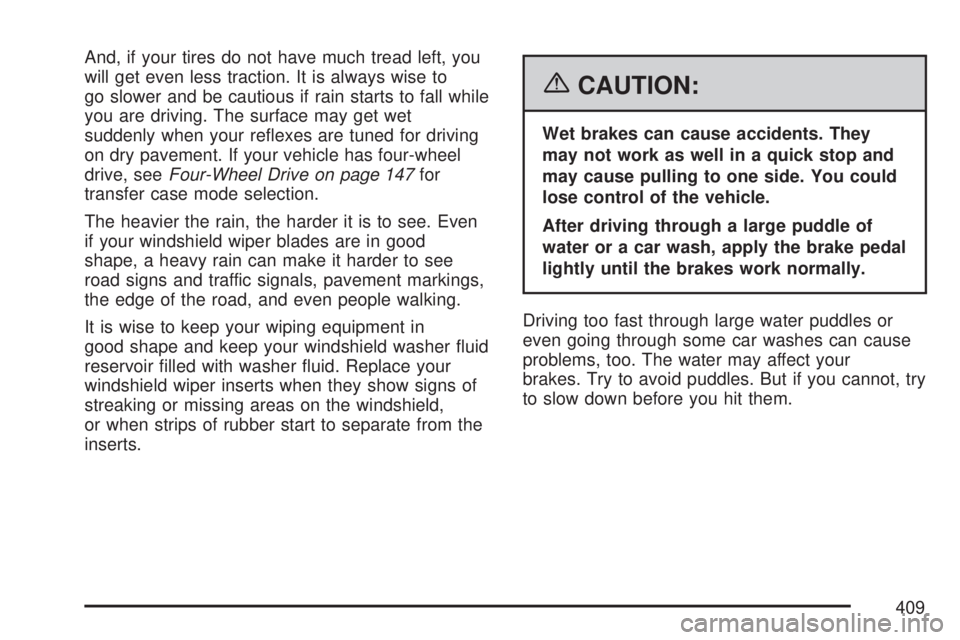
And, if your tires do not have much tread left, you
will get even less traction. It is always wise to
go slower and be cautious if rain starts to fall while
you are driving. The surface may get wet
suddenly when your re�exes are tuned for driving
on dry pavement. If your vehicle has four-wheel
drive, seeFour-Wheel Drive on page 147for
transfer case mode selection.
The heavier the rain, the harder it is to see. Even
if your windshield wiper blades are in good
shape, a heavy rain can make it harder to see
road signs and traffic signals, pavement markings,
the edge of the road, and even people walking.
It is wise to keep your wiping equipment in
good shape and keep your windshield washer �uid
reservoir �lled with washer �uid. Replace your
windshield wiper inserts when they show signs of
streaking or missing areas on the windshield,
or when strips of rubber start to separate from the
inserts.
{CAUTION:
Wet brakes can cause accidents. They
may not work as well in a quick stop and
may cause pulling to one side. You could
lose control of the vehicle.
After driving through a large puddle of
water or a car wash, apply the brake pedal
lightly until the brakes work normally.
Driving too fast through large water puddles or
even going through some car washes can cause
problems, too. The water may affect your
brakes. Try to avoid puddles. But if you cannot, try
to slow down before you hit them.
409
Page 415 of 680
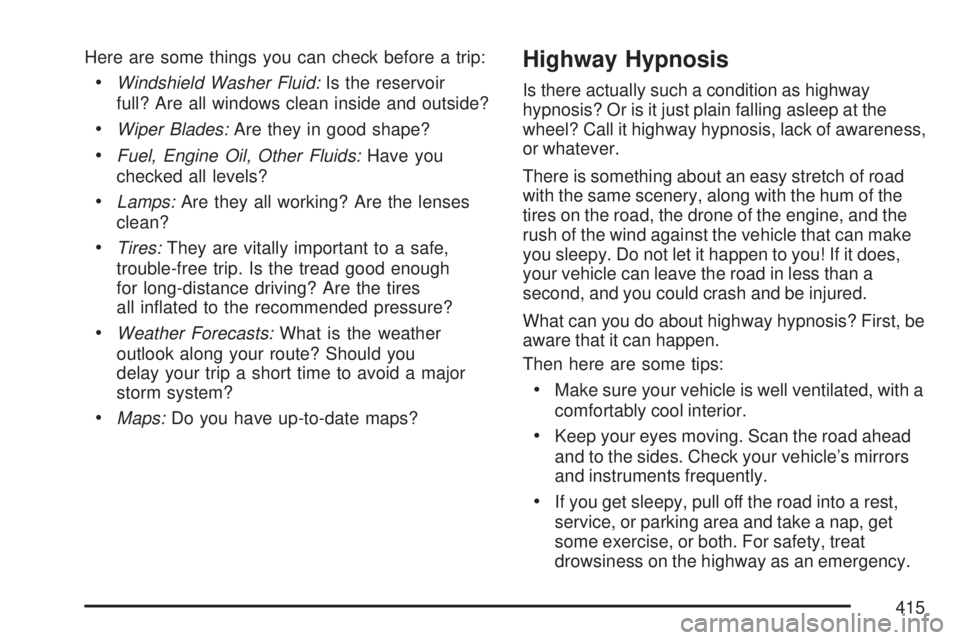
Here are some things you can check before a trip:
Windshield Washer Fluid:Is the reservoir
full? Are all windows clean inside and outside?
Wiper Blades:Are they in good shape?
Fuel, Engine Oil, Other Fluids:Have you
checked all levels?
Lamps:Are they all working? Are the lenses
clean?
Tires:They are vitally important to a safe,
trouble-free trip. Is the tread good enough
for long-distance driving? Are the tires
all in�ated to the recommended pressure?
Weather Forecasts:What is the weather
outlook along your route? Should you
delay your trip a short time to avoid a major
storm system?
Maps:Do you have up-to-date maps?
Highway Hypnosis
Is there actually such a condition as highway
hypnosis? Or is it just plain falling asleep at the
wheel? Call it highway hypnosis, lack of awareness,
or whatever.
There is something about an easy stretch of road
with the same scenery, along with the hum of the
tires on the road, the drone of the engine, and the
rush of the wind against the vehicle that can make
you sleepy. Do not let it happen to you! If it does,
your vehicle can leave the road in less than a
second, and you could crash and be injured.
What can you do about highway hypnosis? First, be
aware that it can happen.
Then here are some tips:
Make sure your vehicle is well ventilated, with a
comfortably cool interior.
Keep your eyes moving. Scan the road ahead
and to the sides. Check your vehicle’s mirrors
and instruments frequently.
If you get sleepy, pull off the road into a rest,
service, or parking area and take a nap, get
some exercise, or both. For safety, treat
drowsiness on the highway as an emergency.
415
Page 485 of 680
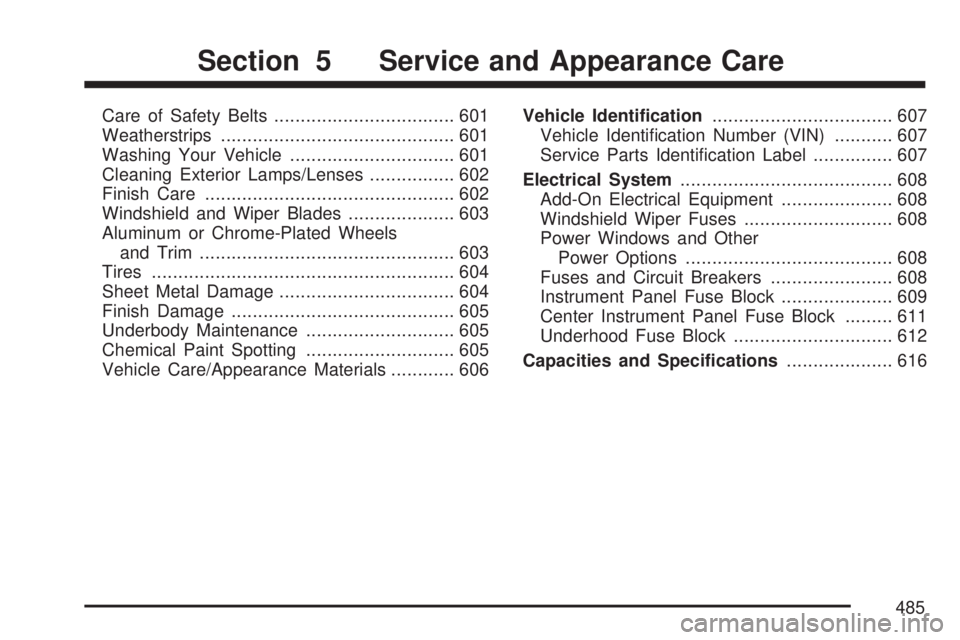
Care of Safety Belts.................................. 601
Weatherstrips............................................ 601
Washing Your Vehicle............................... 601
Cleaning Exterior Lamps/Lenses................ 602
Finish Care............................................... 602
Windshield and Wiper Blades.................... 603
Aluminum or Chrome-Plated Wheels
and Trim................................................ 603
Tires......................................................... 604
Sheet Metal Damage................................. 604
Finish Damage.......................................... 605
Underbody Maintenance............................ 605
Chemical Paint Spotting............................ 605
Vehicle Care/Appearance Materials............ 606Vehicle Identi�cation.................................. 607
Vehicle Identi�cation Number (VIN)........... 607
Service Parts Identi�cation Label............... 607
Electrical System........................................ 608
Add-On Electrical Equipment..................... 608
Windshield Wiper Fuses............................ 608
Power Windows and Other
Power Options....................................... 608
Fuses and Circuit Breakers....................... 608
Instrument Panel Fuse Block..................... 609
Center Instrument Panel Fuse Block......... 611
Underhood Fuse Block.............................. 612
Capacities and Speci�cations.................... 616
Section 5 Service and Appearance Care
485
Page 549 of 680
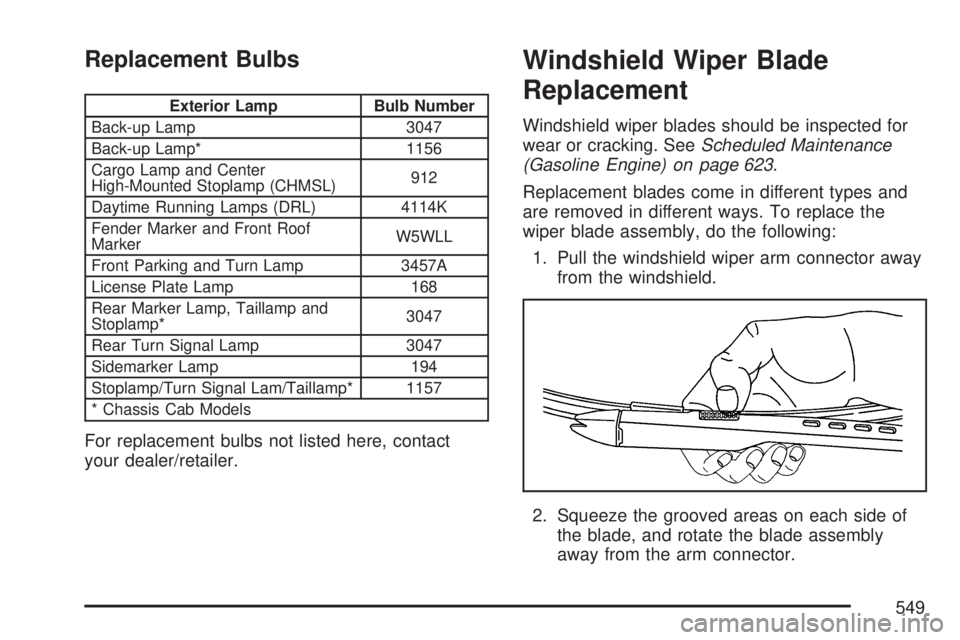
Replacement Bulbs
Exterior Lamp Bulb Number
Back-up Lamp 3047
Back-up Lamp* 1156
Cargo Lamp and Center
High-Mounted Stoplamp (CHMSL)912
Daytime Running Lamps (DRL) 4114K
Fender Marker and Front Roof
MarkerW5WLL
Front Parking and Turn Lamp 3457A
License Plate Lamp 168
Rear Marker Lamp, Taillamp and
Stoplamp*3047
Rear Turn Signal Lamp 3047
Sidemarker Lamp 194
Stoplamp/Turn Signal Lam/Taillamp* 1157
* Chassis Cab Models
For replacement bulbs not listed here, contact
your dealer/retailer.
Windshield Wiper Blade
Replacement
Windshield wiper blades should be inspected for
wear or cracking. SeeScheduled Maintenance
(Gasoline Engine) on page 623.
Replacement blades come in different types and
are removed in different ways. To replace the
wiper blade assembly, do the following:
1. Pull the windshield wiper arm connector away
from the windshield.
2. Squeeze the grooved areas on each side of
the blade, and rotate the blade assembly
away from the arm connector.
549
Page 603 of 680
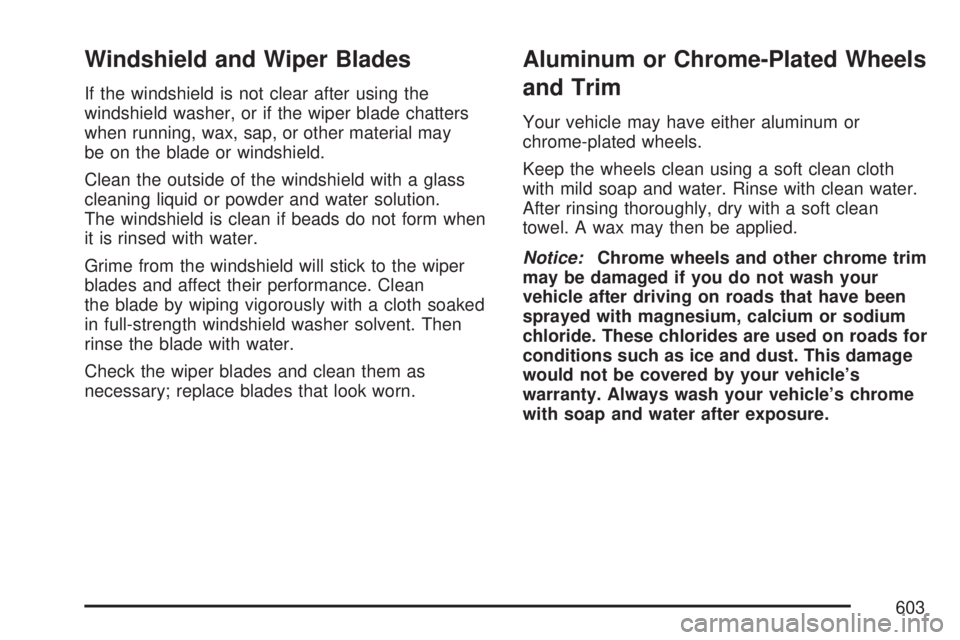
Windshield and Wiper Blades
If the windshield is not clear after using the
windshield washer, or if the wiper blade chatters
when running, wax, sap, or other material may
be on the blade or windshield.
Clean the outside of the windshield with a glass
cleaning liquid or powder and water solution.
The windshield is clean if beads do not form when
it is rinsed with water.
Grime from the windshield will stick to the wiper
blades and affect their performance. Clean
the blade by wiping vigorously with a cloth soaked
in full-strength windshield washer solvent. Then
rinse the blade with water.
Check the wiper blades and clean them as
necessary; replace blades that look worn.
Aluminum or Chrome-Plated Wheels
and Trim
Your vehicle may have either aluminum or
chrome-plated wheels.
Keep the wheels clean using a soft clean cloth
with mild soap and water. Rinse with clean water.
After rinsing thoroughly, dry with a soft clean
towel. A wax may then be applied.
Notice:Chrome wheels and other chrome trim
may be damaged if you do not wash your
vehicle after driving on roads that have been
sprayed with magnesium, calcium or sodium
chloride. These chlorides are used on roads for
conditions such as ice and dust. This damage
would not be covered by your vehicle’s
warranty. Always wash your vehicle’s chrome
with soap and water after exposure.
603
Page 626 of 680
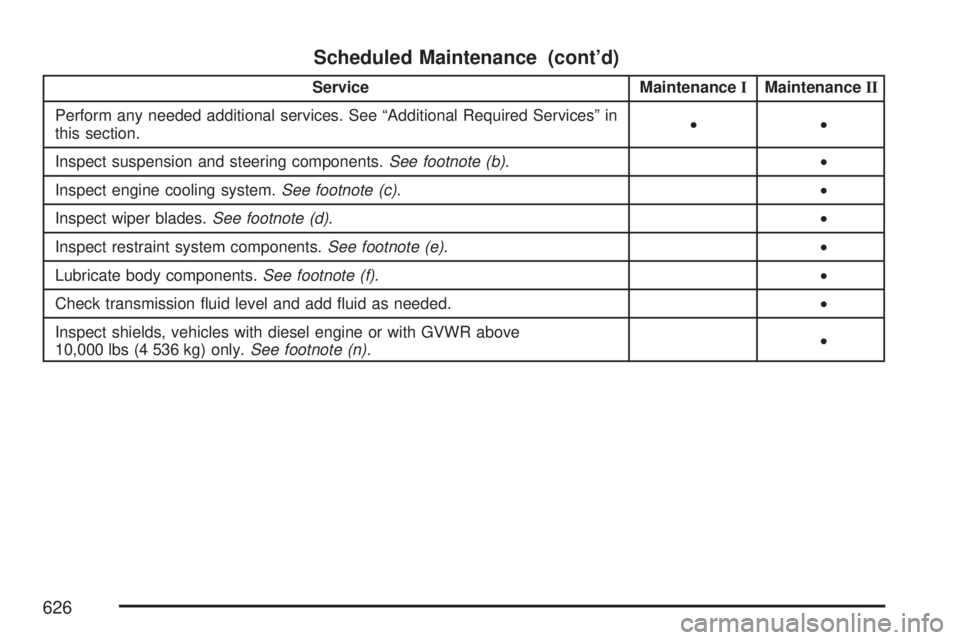
Scheduled Maintenance (cont’d)
Service MaintenanceIMaintenanceII
Perform any needed additional services. See “Additional Required Services” in
this section.••
Inspect suspension and steering components.See footnote (b).•
Inspect engine cooling system.See footnote (c).•
Inspect wiper blades.See footnote (d).•
Inspect restraint system components.See footnote (e).•
Lubricate body components.See footnote (f).•
Check transmission �uid level and add �uid as needed.•
Inspect shields, vehicles with diesel engine or with GVWR above
10,000 lbs (4 536 kg) only.See footnote (n).•
626
Page 629 of 680
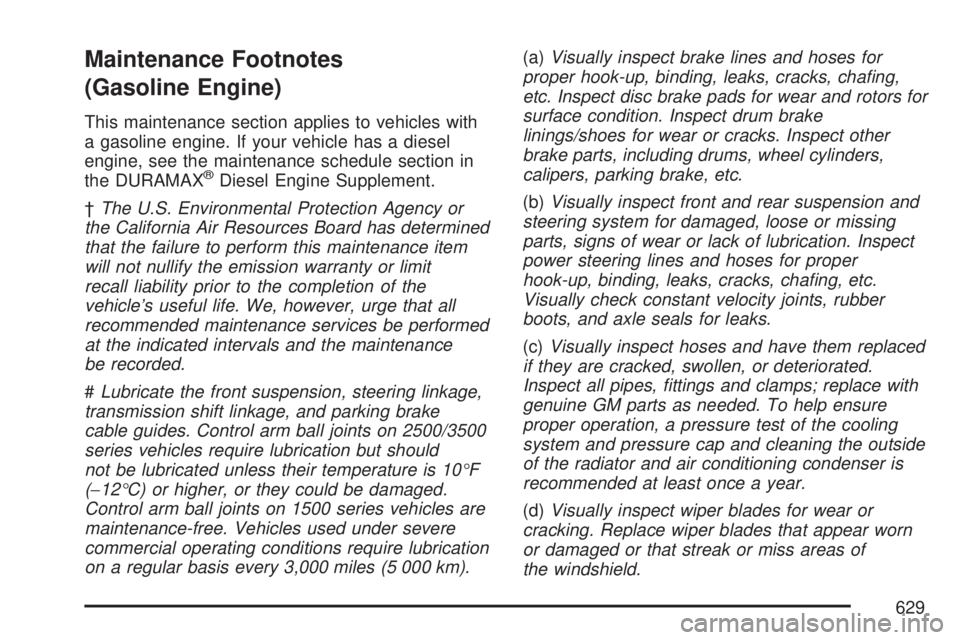
Maintenance Footnotes
(Gasoline Engine)
This maintenance section applies to vehicles with
a gasoline engine. If your vehicle has a diesel
engine, see the maintenance schedule section in
the DURAMAX
®Diesel Engine Supplement.
†The U.S. Environmental Protection Agency or
the California Air Resources Board has determined
that the failure to perform this maintenance item
will not nullify the emission warranty or limit
recall liability prior to the completion of the
vehicle’s useful life. We, however, urge that all
recommended maintenance services be performed
at the indicated intervals and the maintenance
be recorded.
#Lubricate the front suspension, steering linkage,
transmission shift linkage, and parking brake
cable guides. Control arm ball joints on 2500/3500
series vehicles require lubrication but should
not be lubricated unless their temperature is 10°F
(−12°C) or higher, or they could be damaged.
Control arm ball joints on 1500 series vehicles are
maintenance-free. Vehicles used under severe
commercial operating conditions require lubrication
on a regular basis every 3,000 miles (5 000 km).(a)Visually inspect brake lines and hoses for
proper hook-up, binding, leaks, cracks, cha�ng,
etc. Inspect disc brake pads for wear and rotors for
surface condition. Inspect drum brake
linings/shoes for wear or cracks. Inspect other
brake parts, including drums, wheel cylinders,
calipers, parking brake, etc.
(b)Visually inspect front and rear suspension and
steering system for damaged, loose or missing
parts, signs of wear or lack of lubrication. Inspect
power steering lines and hoses for proper
hook-up, binding, leaks, cracks, cha�ng, etc.
Visually check constant velocity joints, rubber
boots, and axle seals for leaks.
(c)Visually inspect hoses and have them replaced
if they are cracked, swollen, or deteriorated.
Inspect all pipes, �ttings and clamps; replace with
genuine GM parts as needed. To help ensure
proper operation, a pressure test of the cooling
system and pressure cap and cleaning the outside
of the radiator and air conditioning condenser is
recommended at least once a year.
(d)Visually inspect wiper blades for wear or
cracking. Replace wiper blades that appear worn
or damaged or that streak or miss areas of
the windshield.
629
Page 638 of 680
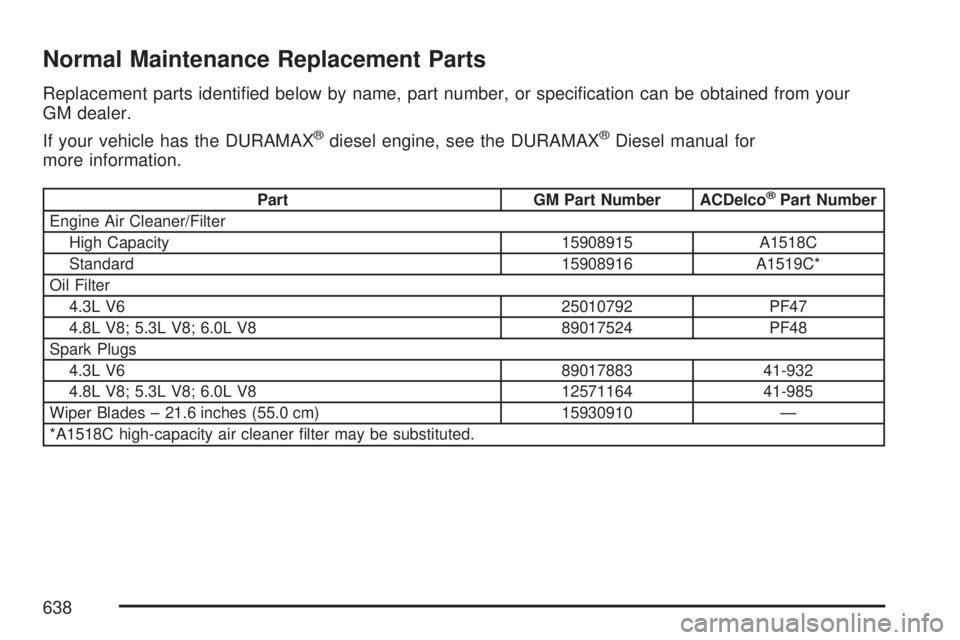
Normal Maintenance Replacement Parts
Replacement parts identi�ed below by name, part number, or speci�cation can be obtained from your
GM dealer.
If your vehicle has the DURAMAX
®diesel engine, see the DURAMAX®Diesel manual for
more information.
Part GM Part Number ACDelco®Part Number
Engine Air Cleaner/Filter
High Capacity 15908915 A1518C
Standard 15908916 A1519C*
Oil Filter
4.3L V6 25010792 PF47
4.8L V8; 5.3L V8; 6.0L V8 89017524 PF48
Spark Plugs
4.3L V6 89017883 41-932
4.8L V8; 5.3L V8; 6.0L V8 12571164 41-985
Wiper Blades – 21.6 inches (55.0 cm) 15930910 —
*A1518C high-capacity air cleaner �lter may be substituted.
638
Page 666 of 680
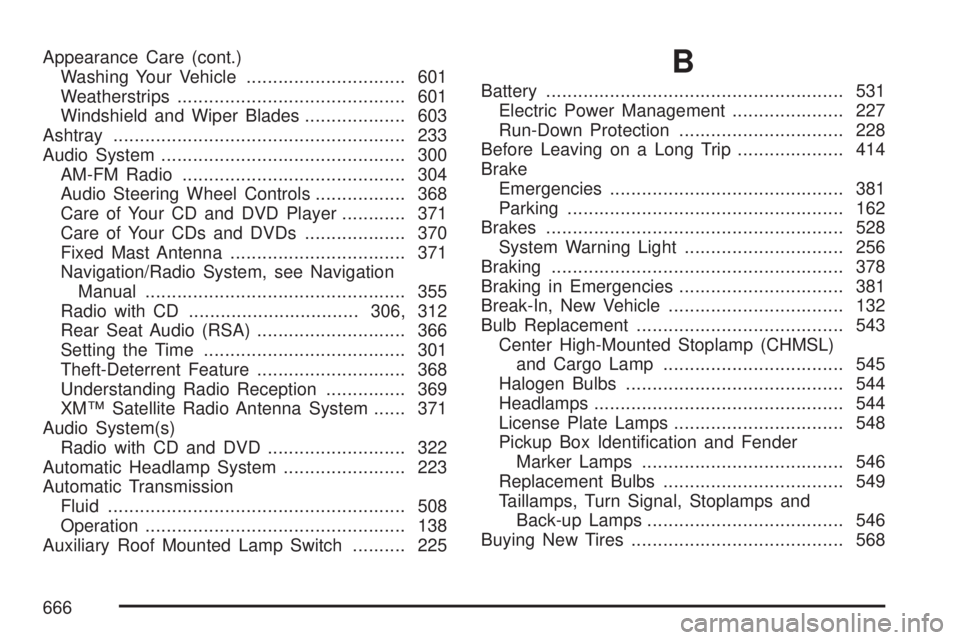
Appearance Care (cont.)
Washing Your Vehicle.............................. 601
Weatherstrips........................................... 601
Windshield and Wiper Blades................... 603
Ashtray....................................................... 233
Audio System.............................................. 300
AM-FM Radio.......................................... 304
Audio Steering Wheel Controls................. 368
Care of Your CD and DVD Player............ 371
Care of Your CDs and DVDs................... 370
Fixed Mast Antenna................................. 371
Navigation/Radio System, see Navigation
Manual................................................. 355
Radio with CD................................306, 312
Rear Seat Audio (RSA)............................ 366
Setting the Time...................................... 301
Theft-Deterrent Feature............................ 368
Understanding Radio Reception............... 369
XM™ Satellite Radio Antenna System...... 371
Audio System(s)
Radio with CD and DVD.......................... 322
Automatic Headlamp System....................... 223
Automatic Transmission
Fluid........................................................ 508
Operation................................................. 138
Auxiliary Roof Mounted Lamp Switch.......... 225B
Battery........................................................ 531
Electric Power Management..................... 227
Run-Down Protection............................... 228
Before Leaving on a Long Trip.................... 414
Brake
Emergencies............................................ 381
Parking.................................................... 162
Brakes........................................................ 528
System Warning Light.............................. 256
Braking....................................................... 378
Braking in Emergencies............................... 381
Break-In, New Vehicle................................. 132
Bulb Replacement....................................... 543
Center High-Mounted Stoplamp (CHMSL)
and Cargo Lamp.................................. 545
Halogen Bulbs......................................... 544
Headlamps............................................... 544
License Plate Lamps................................ 548
Pickup Box Identi�cation and Fender
Marker Lamps...................................... 546
Replacement Bulbs.................................. 549
Taillamps, Turn Signal, Stoplamps and
Back-up Lamps..................................... 546
Buying New Tires........................................ 568
666